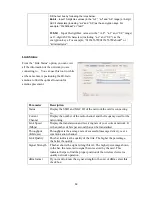
66
problem when transferring
large files
located.
2.
Disable ‘Tx Burst’ in ‘Advanced’ tab.
3.
Enable ‘WMM’ in ‘WMM’ tab if you need to use
multimedia / telephony related applications.
4.
Disable ‘WMM – Power Save Enable’ in ‘WMM’
tab.
5.
There could be too much people using the same radio
channel. Ask the owner of the access point to change
the channel number.
Please try one or more solutions listed above.
6
Glossary
1.
What is the IEEE 802.11g standard?
802.11g is the new IEEE standard for high-speed wireless LAN communications that
provides for up to 54 Mbps data rate in the 2.4 GHz band. 802.11g is quickly becoming
the next mainstream wireless LAN technology for the home, office and public
networks.
802.11g defines the use of the same OFDM modulation technique specified in IEEE
802.11a for the 5 GHz frequency band and applies it in the same 2.4 GHz frequency
band as IEEE 802.11b. The 802.11g standard requires backward compatibility with
802.11b.
The standard specifically calls for:
A.
A new physical layer for the 802.11 Medium Access Control (MAC) in the 2.4 GHz
frequency band, known as the extended rate PHY (ERP). The ERP adds OFDM as a
mandatory new coding scheme for 6, 12 and 24 Mbps (mandatory speeds), and 18,
36, 48 and 54 Mbps (optional speeds). The ERP includes the modulation schemes
found in 802.11b including CCK for 11 and 5.5 Mbps and Barker code modulation
for 2 and 1 Mbps.
B.
A protection mechanism called RTS/CTS that govern how 802.11g devices and
802.11b devices interoperate.
2.
What is the IEEE 802.11b standard?
The IEEE 802.11b Wireless LAN standard subcommittee formulates the standard for
the industry. The objective is to enable wireless LAN hardware from different
manufactures to communicate.
3.
What does IEEE 802.11 feature support?
The product supports the following IEEE 802.11 functions:




































